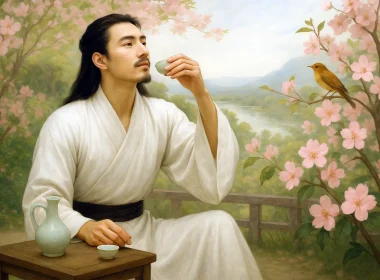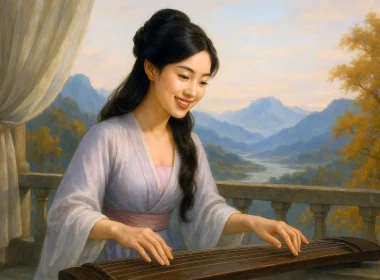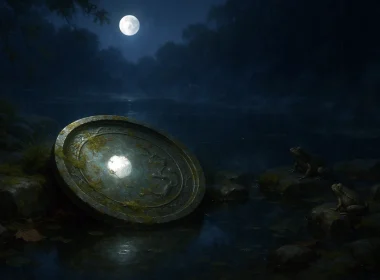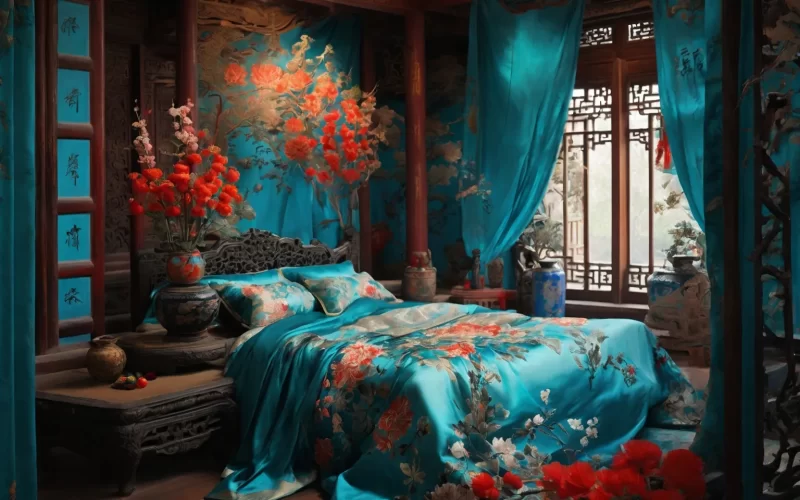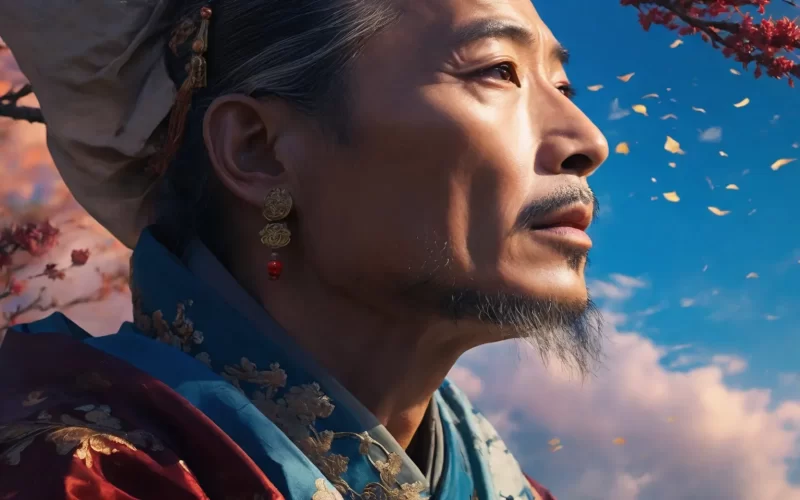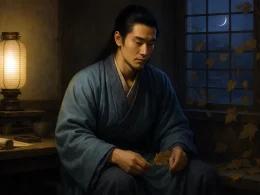Her jade-green alcove curtained thick with silk,
Her vermilion screen with its pattern of flowers,
Her eight-foot dragon-beard mat and her quilt brocaded in squares
Are ready now for nights that are neither warm nor cold.
Original Poem
「已凉」
韩偓
碧阑干外绣帘垂,猩血屏风画折枝。
八尺龙须方锦褥,已凉天气未寒时。
Interpretation
This poem, a masterpiece among Han Wo's romantic works from the late Tang Dynasty, captures the psychological landscape of a noblewoman through exquisite depictions of her boudoir. With restrained brushstrokes and profound imagery, the poet constructs an emotionally resonant portrait of aristocratic solitude.
First Couplet: "碧阑干外绣帘垂,猩血屏风画折枝。"
Bì lángān wài xiù lián chuí, xīng xuè píngfēng huà zhé zhī.
Beyond jade railings, embroidered drapes descend; On vermilion screens, broken branches extend.
The poet opens with a luxurious yet melancholic interior: the "jade railings" and "embroidered drapes" signify refinement, while "vermilion screens" (traditionally associated with nobility) intensify the visual drama. The "broken branches" motif introduces subtle foreboding - a traditional symbol of interrupted youth and beauty's transience, establishing the poem's veiled elegiac tone.
Second Couplet: "八尺龙须方锦褥,已凉天气未寒时。"
Bā chǐ lóng xū fāng jǐn rù, yǐ liáng tiānqì wèi hán shí.
An eight-foot bed with dragon-beard brocade spread, In twilight of autumn, neither warm nor dead.
The description escalates from decor to existential metaphor: the extravagant "dragon-beard brocade" (reserved for elites) contrasts with the transitional season's ambiguity. "Neither warm nor dead" masterfully parallels the woman's emotional limbo - past vitality's peak but not yet resigned to decay. This climatic "twi-light" moment (已凉未寒) becomes an objective correlative for her suspended animation between youth and decline.
Holistic Appreciation
In this four-line poem, three lines depict the environment while one marks the season, yet these environmental descriptions are in truth projections of inner emotions. Han Wo, with his calm and objective brushstrokes, portrays a noblewoman of delicate sensibilities. The rich palette (emerald, scarlet, brocade) and carefully selected objects (embroidered curtains, screens, dragon-whisker rugs) construct a tranquil and elegant space, while subtly hinting at solitude and melancholy. Particularly striking is the closing line, "The weather has turned cool but not yet cold"—where the poet speaks not of "sorrow" nor laments "grievance," but instead uses the shift in nature to mirror emotional chill, revealing profound sentiment through restraint. The poem never directly describes the woman, yet her presence permeates every word; it never explicitly expresses emotion, yet each character overflows with feeling. This technique of revealing emotion through scenery and concealing sentiment within the landscape is a hallmark of the deeply moving style of late Tang poetry.
Artistic Features
- Precise Structure, Progressive Perspective: The poet uses "beyond the railing," "screen," and "bedding" as guiding threads, advancing the visual perspective layer by layer from outside to inside, constructing a tangible and complete sense of space.
- Vivid Colors, Distinct Textures: Words like emerald, scarlet, and brocade precisely convey visual and tactile beauty, enhancing the imagery and aesthetic depth.
- Subtle Emotion, Scenery as Metaphor: The poem's tone remains composed, yet it brims with unspoken sentiment. "Cool but not yet cold" becomes the most potent symbol of emotion, reflecting the woman's delicate musings on the passage of time, solitude, and youth.
Insights
This poem teaches us that poetry does not always reside in overt expressions of emotion but often lingers in the details and atmosphere of life. Through the depiction of objects, one can convey psychological states and the depths of feeling. This method of drawing emotion from stillness and embedding sentiment within scenery holds not only aesthetic value but also guides us to perceive human emotions and worldly affairs with greater sensitivity, revealing the artistic beauty of "movement within stillness, emotion hidden within scenery."
About the Poet
Han Wo (韩偓, 844 – 923 CE), courtesy name Zhiguang (致光) and literary name Yushan Qiaoren (玉山樵人), was a native of Jingzhao Wannian (present-day Xi'an, Shaanxi Province). A prominent statesman and poet of the late Tang dynasty, he was the younger brother of Han Yi (韩仪), an academician of the Hanlin Academy, and one of the "Four Worthies of Nan'an." A devout Taoist, Han Wo was renowned for his palace-style poetry, often characterized by romantic themes and ornate diction, earning his works the epithet "Xianglian Style" (香奁体). In the third year of the Later Liang's Longde era (923 CE), he passed away due to illness at Longxing Temple in Nan'an County and was buried at Kuishan. His extant works include The Collected Works of Yushan Qiaoren (《玉山樵人集》).


